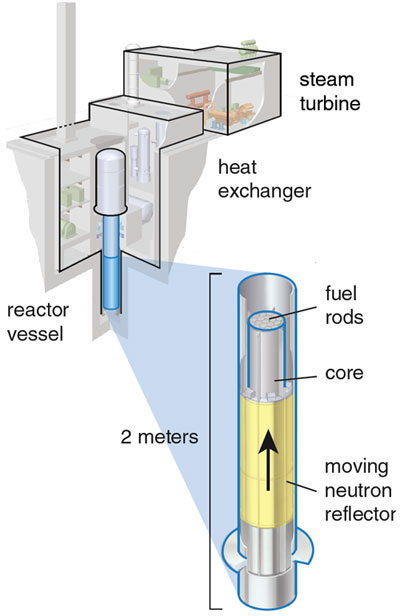ACTUALITE NUCLEAIRE
2009
mars
Un mini-réacteur nucléaire en Alaska?
A Nuke on the Yukon?
http://www.americanscientist.org/
ADIT
Voir aussi 2003, 2008 et 2010!
 Galena, Alaska, could be the type specimen for remoteness. A tiny town of about 700 on a bend of the Yukon River, it has no roads in and depends on the river for food, fuel and supplies. The river is frozen eight to nine months of the year. Galena residents pay three times the national average per kilowatt hour for diesel-generated electricity. Alternative energy would have special appeal for Galena, but with an evening that stretches 20 hours in the winter, solar is out. With the help of Toshiba and its American holding, Westinghouse, Galena is thinking nuclear. Will a swaggering nuclear policy in Galena be the next big headache for nearby Tanana and McGrath? The Toshiba 4S (Super-Safe, Small and Simple) nuclear power plant is designed to be delivered, installed, and carried away 30 years later. It may meet the needs of remote sites around the world. The key to Galena's ambitions is the Toshiba 4S—the Super-Safe, Small and Simple reactor, a torpedo-shaped unit on the drawing board that surrounds a core about 2 meters long and 0.6 meters across. The entire unit, core and casing, is to be manufactured off-site by Toshiba, delivered to the customer, and then lowered into a cylindrical concrete vault 30 meters underground. Expected to run for 30 years with minimal operator intervention, the 4S is designed to pump out 10 megawatts of electric power, just 1% of the output of conventional nuclear power plants. When the nuclear fuel is exhausted after three decades, Toshiba will extract the 4S and take it away, presumably leaving behind a replacement (which for all we know will be the size of a beachball by then). Tony Grenci, principal engineer at Westinghouse and lead for the licensing process, reports that the remote-community application is likely to be the first use for the 4S, but that other roles will probably be more important overall, such as supplying power for mining, desalinization, oil-sands operations and remote research facilities. Discussions about the Galena-Toshiba project began in 2005 and have been proceeding at regulatory speed—which is to say, slowly. Initially, Toshiba offered to install the unit for free as a pilot project, with Galena arranging to finance the operating costs and Toshiba leading the effort to acquire regulatory approval. The Nuclear Regulatory Commission (NRC) is widely regarded as a government entity that does well what it is supposed to do. It offers consultation at the pre-design and pre-application stage, and imposes a notoriously arduous review of applications that seems to generate little complaint. Everyone understands how high the stakes are. (suite)
|
suite:
Toshiba/Westinghouse initiated discussions with the NRC in 2007 and had its fourth pre-application meeting in late 2008. The current plan is to file for design approval in 2009. After that comes filing for a site permit, which takes into account environmental information specific to the operating site, and a Combined Construction and Operating License, allowing the plant to be built and fired up. Grenci is unwilling to project a date for first steam—original estimates of 2012 now seem implausible—"but we're going great guns on this." Technologically, the 4S is a captivating item. Cylindrical fuel rods 2 meters long surround an inner neutron absorber, and the fuel rods are surrounded by a neutron-reflecting collar. Operation begins with the collar covering just the bottom portion of the fuel rods, reflecting scattered neutrons back into the fuel. Slowly the collar creeps up the length of the fuel-rod assembly, exhausting the fuel it surrounds until it reaches the top of the fuel rods 30 years later. The reactor is cooled by liquid sodium, and the heat generated is transferred to steam turbines in a separate structure. Among the designed-in safety features are the mechanisms for cycling the liquid-metal coolant through the reactor: electromagnetic pumps, which have no moving parts to fail, and the routing of the coolant, which is designed to transport the sodium by convection alone if the pumps fail. The choice of sodium instead of water for the coolant is itself a safety consideration, because the sodium channels aren't pressurized. A leak would be a serious problem, but in a crisis, molten sodium seeps. The high-temperature, high-pressure water-cooling systems of conventional reactors explode. A recent rise of commercial interest in nuclear power has been called the nuclear renaissance. The technology for big plants is becoming more robust, the regulatory process is being streamlined as the heritage of experience gets deeper, new-plant costs are coming down just as the prices of conventional energy sources such as oil and gas become increasingly volatile, and climate change has many players taking a fresh look at nuclear. Ironically, the renaissance may work against Galena and Toshiba/Westinghouse. At least 29 new big reactors are at various stages of planning, and the NRC is staffing up for an anticipated burst in the number of filings for approval. (There are 104 nuclear plants currently operating in the U.S.) The Office of New Reactors at the NRC has advised Toshiba that only limited attention will be given through 2010 to "grid-appropriate" (their term for small) reactor designs. It remains to be seen whether the incoming Obama administration will take a more enthusiastic view of small nukes, or a more sympathetic view of citizens in the outlands. In the NRC's 4S file, a letter from the licensing lead for a competing "grid-appropriate" reactor, the Hyperion Power Module (the size of a hot tub, at least on the drawing board), reads "These are areas that are paying through the nose for diesel fuel to keep the lights on. Some are charging 47 cents per kWh, and a lot of people are sitting in the dark." |